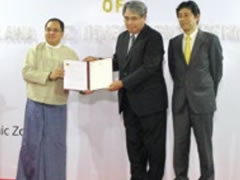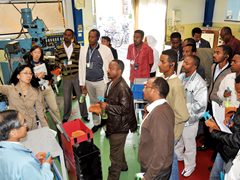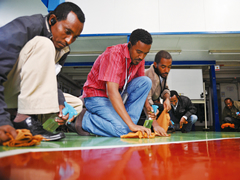Myanmar: The Project for Capacity Building of Thilawa SEZ Management Committee
Supporting Expeditious Investment Procedures with an Efficient One-Stop Service
In the Thilawa Special Economic Zone (SEZ) in Myanmar, which is set to start operations in autumn 2015, efforts have been made to speed up the processes of obtaining an investment permit as well as building and environmental permits and licenses through a one-stop service. These efforts are highly valued by foreign companies operating in the country.
Investment Permits Already Granted to 36 Companies
The Thilawa SEZ is a public-private project being undertaken by the governments of Japan and Myanmar. To support this SEZ, JICA has been extending comprehensive assistance that combines various ODA schemes, including Private-Sector Investment Finance, ODA Loans, Grant Aid, and Technical Cooperation.
In September 2014, JICA started the project to launch the SEZ Management Committee and the One Stop Service Center (OSSC) smoothly and to operate and manage the SEZ effectively. In November 2014, the first investment permit was granted to a Japanese SME. By June 2015, a total of 36 companies were granted investment permits and 11 of them commenced construction work. Officials from nine government offices concerned are working at the OSSC to streamline the processes of obtaining permits and licenses.

The first investment permit granted to the representative of a Japanese company
The track record shows that it takes two to three weeks on average to complete the procedures for obtaining an investment permit after an application is accepted. The OSSC handles all the procedures, including receiving and processing applications for company registration, visas, and residence permits.
The system for speeding up the investment procedures and one-stop services are nearing completion through these activities, attracting high marks from Japanese companies and other investors.
Case Study
Ethiopia: The Study on Quality and Productivity Improvement (KAIZEN)
Expanding a Cycle of Improvement to Enhance Productivity
Learning about kaizen through lectures and observation
Kaizen, or continuous improvement, refers to bottom-up activities aimed at enhancing productivity at Japanese enterprises. It has become an internationally recognized concept, and one that Ethiopia expressed interest in after reviewing the results of JICA initiatives in Tunisia. JICA activities have been taking root in Africa.
Birth of Africa's First KAIZEN Unit
Various officials from Ethiopia visited a manufacturing company in Osaka as part of their training under the Study on Quality and Productivity Improvement (KAIZEN Project). Here, they observed the well-organized tools, the place for office supplies, the colored switches and the meticulously clean, safe and comfortable production facility.

Learning about kaizen through lectures and observation
"It's a very practical initiative," comments Delo Benka of the KAIZEN Unit at Ethiopia's Ministry of Trade and Industry. "We first implemented kaizen activities at my office, and now we want to introduce them to the corporate sector in Ethiopia." Gashaw Taye, who worked at a foodstuffs company, had the following to say: "I want to incorporate some of the kaizen ideas immediately, such as modifying storage space according to the frequency of use and employing different colored light switches."
Ethiopian Prime Minister Meles Zenawi spearheaded the call for JICA support to learn from successful experiences in Asia, which led to the start of a two-year "kaizen project" in October 2009. Kaizen refers to bottom-up activities developed by Japanese enterprises that employees undertake on site to bring continuous improvements to quality and productivity company-wide. Such activities have played a major role in maintaining and enhancing quality in Japanese goods.
Ethiopia set up the KAIZEN Unit within the Ministry of Trade and Industry to promote kaizen. This was the first time in Africa the term kaizen was used in a ministerial department name.
The project comprises three parts: (1) A pilot project to examine and provide guidance to 30 companies in Ethiopia; (2) Formulation of a national plan to spread an Ethiopian version of kaizen reflecting the results of the pilot project; and (3) Development of human resources for promoting kaizen.
As part of these efforts, 10 staff members from the KAIZEN Unit and 30 members from the 30 enterprises engaged in the pilot project visited Japan in May 2010, and over a two-week period learned how to implement 3S (Seiri (tidiness), Seiton (orderliness) and Seiso (cleanliness)) and QC (quality Control) activities through lectures, observation and interaction with factory employees.
Together with staff members from the KAIZEN Unit, JICA consultants will visit each pilot company before the end of 2010 to implement the pilot project. With the cooperation of Japan's National Graduate Institute for Policy Studies, JICA will formulate a national plan to spread kaizen activities with the Ethiopian side.
Expanding Kaizen Activities
Trainees implement the element of seiso (cleanliness) of the 5S concept
The Study on the Master Plan for Quality/Productivity Improvement that JICA conducted in Tunisia in 2006 was the catalyst for the introduction of kaizen activities in Ethiopia.
Of the 29 companies participating in the project in Tunisia, 60% improved productivity in some way or another while around 30% made an overall improvement in productivity. Other countries in addition to Ethiopia have expressed interest in learning from Japan's successful experiences in Asia.
JICA is helping to raise productivity at companies in various African countries by widely introducing actual cases in Tunisia and Ethiopia through seminars and other means.

Trainees implement the element of seiso (cleanliness) of the 5S concept




scroll